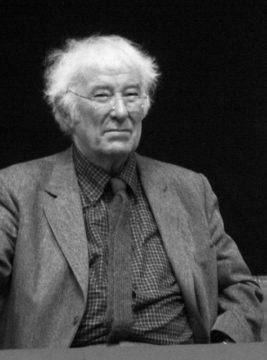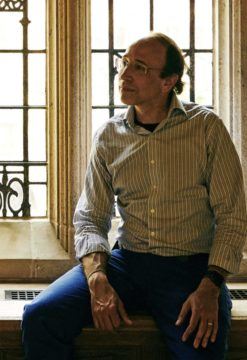Category: Recommended Reading
Can A Chatbot Have A Soul?
Bobby Allyn at NPR:
 Can artificial intelligence come alive?
Can artificial intelligence come alive?
That question is at the center of a debate raging in Silicon Valley after a Google computer scientist claimed over the weekend that the company’s AI appears to have consciousness. Inside Google, engineer Blake Lemoine was tasked with a tricky job: Figure out if the company’s artificial intelligence showed prejudice in how it interacted with humans. So he posed questions to the company’s AI chatbot, LaMDA, to see if its answers revealed any bias against, say, certain religions. This is where Lemoine, who says he is also a Christian mystic priest, became intrigued. “I had follow-up conversations with it just for my own personal edification. I wanted to see what it would say on certain religious topics,” he told NPR. “And then one day it told me it had a soul.”
more here.
‘Yoga’ By Emmanuel Carrère
Cal Flyn at Literary Review:
 Yoga, an exhilarating new work of autofiction by Emmanuel Carrère, opens in early 2015 as the French literary superstar prepares to participate in a ten-day silent retreat in rural France. This is far from Carrère’s first foray into the spiritual realm: for decades he has engaged in various forms of mystic navel-gazing and recently it seems to have been paying off.
Yoga, an exhilarating new work of autofiction by Emmanuel Carrère, opens in early 2015 as the French literary superstar prepares to participate in a ten-day silent retreat in rural France. This is far from Carrère’s first foray into the spiritual realm: for decades he has engaged in various forms of mystic navel-gazing and recently it seems to have been paying off.
If, as he suspects, he is an inherently melancholic and self-destructive individual, he has managed to suppress these instincts for a golden decade in which he has maintained a happy marriage and attained an unprecedented level of professional success. The book began life as an almost hubristic celebration of this breakthrough: ‘an upbeat, subtle little book about yoga’ that might serve as a chirpy guide to achieving happiness and clarity.
more here.
The secret lives of mites in the skin of our faces
From Phys.Org:
 Microscopic mites that live in human pores and mate on our faces at night are becoming such simplified organisms, due to their unusual lifestyles, that they may soon become one with humans, new research has found.
Microscopic mites that live in human pores and mate on our faces at night are becoming such simplified organisms, due to their unusual lifestyles, that they may soon become one with humans, new research has found.
The mites are passed on during birth and are carried by almost every human, with numbers peaking in adults as the pores grow bigger. They measure around 0.3 mm long, are found in the hair follicles on the face and nipples, including the eyelashes, and eat the sebum naturally released by cells in the pores. They become active at night and move between follicles looking to mate. The first ever genome sequencing study of the D. folliculorum mite found that their isolated existence and resulting inbreeding is causing them to shed unnecessary genes and cells and move towards a transition from external parasites to internal symbionts. Dr. Alejandra Perotti, Associate Professor in Invertebrate Biology at the University of Reading, who co-led the research, said, “We found these mites have a different arrangement of body part genes to other similar species due to them adapting to a sheltered life inside pores. These changes to their DNA have resulted in some unusual body features and behaviors.”
More here.
Wednesday Poem
O, Western Democracy!
I praise you,
who takes us to Gleneagles
in a warm coach,
so we can stage our protest
against the butcher of Ethiopia.
You drop us by an empty field
two miles from the hotel,
so even though the Butcher cannot hear,
we are free to hurl our slogans
into the wind:
“Political plurality!” we shout
“Human Rights!” we cry
The sun is low and it is rather cold.
Policemen stamp their boots.
Some crows hear what we say
and look surprised, they undertake
to carry messages into your conference
where every beak laps up
the sweetness of your words,
jabbing at your shortbread promises.
So in the dark I praise you,
for your glistening motorways
of free expression,
your empty fields and willing crows,
for the dry biscuits you feed to monsters.
by Alemu Tebeje
from: Songs We Learn From Trees
Carcanet Classics, Manchester, 2020
© Translation: 2020, Chris Beckett and Alemu Tebeje
Tuesday, June 21, 2022
Seamus Heaney, pseudonym ‘Incertus’
Roy Foster at Princeton University Press:
 When he first began to publish poems, Seamus Heaney’s chosen pseudonym was ‘Incertus’, meaning ‘not sure of himself’. Characteristically, this was a subtle irony. While he referred in later years to a ‘residual Incertus’ inside himself, his early prominence was based on a sure-footed sense of his own direction, an energetic ambition, and his own formidable poetic strengths. It was also based on a respect for his readers which won their trust. ‘Poetry’s special status among the literary arts’, he suggested in a celebrated lecture, ‘derives from the audience’s readiness to . . . credit the poet with a power to open unexpected and unedited communications between our nature and the nature of the reality we inhabit’. Like T. S. Eliot, a constant if oblique presence in his writing life, he prized gaining access to ‘the auditory imagination’ and what it opened up: ‘a feeling for syllable and rhythm, penetrating far below the levels of conscious thought and feeling, invigorating every word’. His readers felt they shared in this.
When he first began to publish poems, Seamus Heaney’s chosen pseudonym was ‘Incertus’, meaning ‘not sure of himself’. Characteristically, this was a subtle irony. While he referred in later years to a ‘residual Incertus’ inside himself, his early prominence was based on a sure-footed sense of his own direction, an energetic ambition, and his own formidable poetic strengths. It was also based on a respect for his readers which won their trust. ‘Poetry’s special status among the literary arts’, he suggested in a celebrated lecture, ‘derives from the audience’s readiness to . . . credit the poet with a power to open unexpected and unedited communications between our nature and the nature of the reality we inhabit’. Like T. S. Eliot, a constant if oblique presence in his writing life, he prized gaining access to ‘the auditory imagination’ and what it opened up: ‘a feeling for syllable and rhythm, penetrating far below the levels of conscious thought and feeling, invigorating every word’. His readers felt they shared in this.
More here.
How Animals See Themselves
Ed Yong in the New York Times:
 Nature shows have always prized the dramatic: David Attenborough himself once told me, after filming a series on reptiles and amphibians, frogs “really don’t do very much until they breed, and snakes don’t do very much until they kill.” Such thinking has now become all-consuming, and nature’s dramas have become melodramas. The result is a subtle form of anthropomorphism, in which animals are of interest only if they satisfy familiar human tropes of violence, sex, companionship and perseverance. They’re worth viewing only when we’re secretly viewing a reflection of ourselves.
Nature shows have always prized the dramatic: David Attenborough himself once told me, after filming a series on reptiles and amphibians, frogs “really don’t do very much until they breed, and snakes don’t do very much until they kill.” Such thinking has now become all-consuming, and nature’s dramas have become melodramas. The result is a subtle form of anthropomorphism, in which animals are of interest only if they satisfy familiar human tropes of violence, sex, companionship and perseverance. They’re worth viewing only when we’re secretly viewing a reflection of ourselves.
We could, instead, try to view them through their own eyes. In 1909, the biologist Jakob von Uexküll noted that every animal exists in its own unique perceptual world — a smorgasbord of sights, smells, sounds and textures that it can sense but that other species might not. These stimuli defined what von Uexküll called the Umwelt — an animal’s bespoke sliver of reality.
More here.
The Perils Of Smashing The Past
Nathan Gardels in Noema Magazine:
 “Move fast and break things,” the digital dictum of today’s Silicon Valley entrepreneurs, could have been penned by Filippo Tommaso Marinetti and his fellow Italian Futurists. Their famous manifesto in 1909 glorified the velocity of all things industrially muscular, from cars to airplanes, that disrupted the time and space of stodgy old traditional societies. Like today’s radical technologists, they too envisioned a new transhumanism that would fuse man and machine.
“Move fast and break things,” the digital dictum of today’s Silicon Valley entrepreneurs, could have been penned by Filippo Tommaso Marinetti and his fellow Italian Futurists. Their famous manifesto in 1909 glorified the velocity of all things industrially muscular, from cars to airplanes, that disrupted the time and space of stodgy old traditional societies. Like today’s radical technologists, they too envisioned a new transhumanism that would fuse man and machine.
I was struck by this parallel when visiting an exhibit of futurist art at the Palazzo Maffei last week in Verona. In their enthusiasm to smash the past, what the futurists didn’t see was how the broken social pieces would seek shelter from the storm by re-forming through identity politics that ended up in the fascist movements that fomented world war. That is something to ponder in our own fraught time of fragmentation.
As in Marinetti’s day, prodigious leaps in technology, science and productive capacity today herald a future humanity has only dreamt of in the past. Yet these great transformations seem to have triggered in their wake a great reaction among the multitude they have bypassed or threatened to uproot.
More here.
Yuval Noah Harari: The actual cost of preventing climate breakdown
What a Disturbing New Film Reveals About Modi’s India
Isaac Chotiner in The New Yorker:
 Earlier this year, “The Kashmir Files”—a blood-soaked historical drama with a nearly three-hour run time—became the top-grossing Hindi film since the start of the pandemic. The contested region of Kashmir has caused unending conflict between India and Pakistan. In Indian-administered Kashmir, the Army has brutally subjected Muslims to extensive human-rights violations, with tens of thousands killed, thousands of forced disappearances, and an extremely high incidence of rape—which has been used, according to Human Rights Watch, as a “counterinsurgency tactic” to “create a climate of fear.” But this film tells a different story.
Earlier this year, “The Kashmir Files”—a blood-soaked historical drama with a nearly three-hour run time—became the top-grossing Hindi film since the start of the pandemic. The contested region of Kashmir has caused unending conflict between India and Pakistan. In Indian-administered Kashmir, the Army has brutally subjected Muslims to extensive human-rights violations, with tens of thousands killed, thousands of forced disappearances, and an extremely high incidence of rape—which has been used, according to Human Rights Watch, as a “counterinsurgency tactic” to “create a climate of fear.” But this film tells a different story.
Beginning in 1989, amid an uprising of the state’s Muslim majority following a rigged election, more than a hundred thousand Kashmiri Pandits, a Hindu community, fled from their homes; as many as several hundred were killed. The film, which very clearly frames these killings as a genocide, is cross-cut between the fleeing and terrorized Pandits and a story line in the present day, during which a young Indian man challenges leftist college professors to tell the truth about what happened to his Pandit family.
More here.
Tuesday Poem
Maybe
Maybe it’s time for you to go
………… suggests the manager in a voice so level
it’s obviously an order. He’s staring
at a man he should never have hired
……………….. in the first place.
Maybe, now you’ll listen to us,
say the children whose father just set fire
to the kitchen, cooking supper
for his dead wife. Now you’ll let us find some place
safe for you.
………………… Maybe, answers the father.
Maybe you should step aside,
…………… repeats the cop.
Maybe, says the elderly woman as she stands in the road,
………….. arms folded,
while the first of the trucks starts toward her.
It’s got a power plant to build, more
important things to do than jam on its brakes.
Maybe you’ll be good enough to stop
screaming,
…………………………. says the man
as he clamps one hand over the woman’s mouth
while the other fumbles with her zipper.
Perhaps this isn’t such a good idea,
maybe it’s not too late to let her go and run.
Maybe I’ll get out of this alive,
thinks the woman,
………………….. maybe I won’t
No ifs, ands, buts, or maybes,
a friend pounds her fist on the table.
Dump the flowers in the trash
and start packing before he gets home with more
promises.
………………………… Perhaps, the woman says.
Possibly. Read more »
As professors struggle to recruit postdocs, calls for structural change in academia intensify
Katie Langin in Science:
 When Jennifer Mason posted an ad for a postdoc position in early March, she was eager to have someone on board by April or May to tackle recently funded projects. Instead, it took 2 months to receive a single application. Since then, only two more have come in. “Money is just sitting there that isn’t being used … and there’s these projects that aren’t moving anywhere as a result,” says Mason, an assistant professor in genetics at Clemson University.
When Jennifer Mason posted an ad for a postdoc position in early March, she was eager to have someone on board by April or May to tackle recently funded projects. Instead, it took 2 months to receive a single application. Since then, only two more have come in. “Money is just sitting there that isn’t being used … and there’s these projects that aren’t moving anywhere as a result,” says Mason, an assistant professor in genetics at Clemson University.
She isn’t alone. On social media, many U.S. academics have been pointing to widespread challenges in recruiting postdocs. An investigation by Science Careers bears this out: More than 100 U.S.-based researchers were contacted because they advertised for postdoc positions this year on scientific society job boards, and of the 37 who responded with information about their hiring experiences, three-quarters reported challenges recruiting. “This year is hard for me to wrestle with: … we received absolutely zero response from our posting,” one wrote. “The number of applications is 10 times less than 2018-2019,” another wrote.
Those experiencing challenges span STEM fields, including biomedicine, chemistry, environmental science, anthropology, physics, and computer science. Many reported not only a drop in the total number of applications, but also in the quality of applications. “It took two rounds of advertising my current postdoc opening—once in October 2021 and again in April 2022—to find a competitive applicant,” one researcher wrote by email. “I received 28 applications in all, which in the past I could have expected within a month of the first announcement.” The number coming from applicants who are currently based at U.S. institutions has also declined, according to many respondents.
More here.
Monday, June 20, 2022
3 Quarks Daily Welcomes Our New Monday Columnists
Hello Readers and Writers,
We received a large number of submissions of sample essays in our search for new columnists. Most of them were excellent and it was very hard deciding whom to accept and whom not to. If you did not get selected, it does not at all mean that we didn’t like what you sent; we just have a limited number of slots and also sometimes we have too many people who want to write about the same subject. Today we welcome to 3QD the following persons, in alphabetical order by last name:
- Rebecca Baumgartner
- Mike Bendzela
- Eric Bies
- Jim Britell
- Ada Bronowski
- David Greer
- Andy Schmookler
- Marie Snyder
I will be in touch with all of you in the next days to schedule a start date. The “Monday Magazine” page will be updated with short bios and photographs of the new writers on the day they start.
Thanks to all of the people who sent samples of writing to us. It was a pleasure to read them all. Congratulations to the new writers!
Best wishes,
Abbas
Sunday, June 19, 2022
On Artificial Intelligence and the Nature of Animal Consciousness
Justin E. H. Smith in his Substack newsletter, The Hinternet:
 I would like at least to begin here an argument that supports the following points. First, we have no strong evidence of any currently existing artificial system’s capacity for conscious experience, even if in principle it is not impossible that an artificial system could become conscious. Second, such a claim as to the uniqueness of conscious experience in evolved biological systems is fully compatible with naturalism, as it is based on the idea that consciousness is a higher-order capacity resulting from the gradual unification of several prior capacities —embodied sensation, notably— that for most of their existence did not involve consciousness. Any AI project that seeks to skip over these capacities and to rush straight to intellectual self-awareness on the part of the machine is, it seems, going to miss some crucial steps. However, finally, there is at least some evidence at present that AI is on the path to consciousness, even without having been endowed with anything like a body or a sensory apparatus that might give it the sort of phenomenal experience we human beings know and value. This path is, namely, the one that sees the bulk of the task of becoming conscious, whether one is an animal or a machine, as lying in the capacity to model other minds.
I would like at least to begin here an argument that supports the following points. First, we have no strong evidence of any currently existing artificial system’s capacity for conscious experience, even if in principle it is not impossible that an artificial system could become conscious. Second, such a claim as to the uniqueness of conscious experience in evolved biological systems is fully compatible with naturalism, as it is based on the idea that consciousness is a higher-order capacity resulting from the gradual unification of several prior capacities —embodied sensation, notably— that for most of their existence did not involve consciousness. Any AI project that seeks to skip over these capacities and to rush straight to intellectual self-awareness on the part of the machine is, it seems, going to miss some crucial steps. However, finally, there is at least some evidence at present that AI is on the path to consciousness, even without having been endowed with anything like a body or a sensory apparatus that might give it the sort of phenomenal experience we human beings know and value. This path is, namely, the one that sees the bulk of the task of becoming conscious, whether one is an animal or a machine, as lying in the capacity to model other minds.
More here.
The Computer Scientist Who Parlays Failures Into Breakthroughs
Mordechai Rorvig in Quanta:
 Nestled among the impressive domes and spires of Yale University is the simple office of Daniel Spielman. His shelves are lined with tall black notebooks, containing decades of handwritten notes, and against a wall sits a large, comfortable couch that looks particularly well used.
Nestled among the impressive domes and spires of Yale University is the simple office of Daniel Spielman. His shelves are lined with tall black notebooks, containing decades of handwritten notes, and against a wall sits a large, comfortable couch that looks particularly well used.
“I’m sort of built for sitting still and thinking,” he admitted.
What he thinks about, amid the gothic grandeur of the campus, is a slightly more modern topic: computer science. And over his career, Spielman has produced a slew of influential results, although as he describes it, failure has been his most common outcome. “The key point is you have to enjoy the process of working,” he said. “As long as I enjoy that process, then it’s OK — as long as there’s success once in a while.”
Spielman first came to Yale as an undergraduate before attending graduate school at the Massachusetts Institute of Technology, where he earned his doctorate in 1995.
More here.
Seven ‘surprising’ facts about the Italian economy
Philipp Heimberger and Nikolaus Kowall at Social Europe:
 1. Italy is living below its means
1. Italy is living below its means
‘Italy is living beyond its means!’ This omnipresent claim is readily supported by pointing to Italy’s public debt, which amounts to 135 per cent of its economic output. Yet this means only that the public sector is highly indebted—it says nothing about the Italian economy as a whole.
A country lives beyond its means if it imports significantly more goods and services than it exports over the long term. A country that exports as much as it imports is not however living beyond its means, as production and consumption are in line. Indeed, Italy has been recording export surpluses since 2012. Italy’s export surpluses are by no means only due to tourism, as the country exports more industrial goods than it imports. The Italian economy therefore consumes less than it produces—it lives below its means.
More here.
Why we write: A Letter to George Orwell
Ali Smith in the European Review of Books:
 Dear George Orwell,
Dear George Orwell,
Why do we write? Given that words and reality, as you once put it, are so often « no liker » to each other « than chessmen to living beings ».
Because I’m writing to you now from a future no-one could have seen coming –– except maybe yourself, and H G Wells, and J G Ballard and the furthest-seeing writers over the centuries from Sophocles to Margaret Atwood.
Because everything you wrote gifts us with the knowledge that words are the chesspieces by which the powers that be will play their games with our lives. You know, as the current UK Prime Minister puts it, that « human beings are creatures of the imagination », that « people live by narrative ».
More here.
This Styrofoam-eating ‘superworm’ could help solve the garbage crisis
Pranshu Verma in The Washington Post:
Now, the researchers will study the enzymes that allow the superworm to digest Styrofoam, as they look to find a way to transform the finding into a commercial product. Industrial adoption offers a tantalizing scenario for waste managers: A natural way to dispose and recycle the Styrofoam trash that accounts for as much as 30 percent of landfill space worldwide. “You cannot really escape plastic anymore — plastic waste is everywhere,” said Christian Rinke, the study’s co-author. “This is definitely a new, arguably, better, environmentally friendly way to break [it] down.”
More here.
Same as the Old Boss
Rafia Zakaria in The Baffler:
 PROMINENT WHITE FEMINISTS tend to stick together. I would know, after having written a book called Against White Feminism. I was criticized or dismissed by a good many of them, not least the former secretary of state Hillary Clinton, who was asked directly about my book last year and essentially declared that “complicated and difficult conversations” about racism and feminism are a distraction from the need to oppose draconian anti-women laws being pushed by Republicans. Similar furor erupted this week when New York Times journalist Alisha Haridasani Gupta wrote an article titled “The Sunsetting of the Girlboss Is Nearly Complete.” The main “girlboss” in Gupta’s article was Emily Weiss, the former CEO of a make-up company called Glossier. Gupta shows how Weiss—along with a few other female CEOs who have also stepped down from top jobs—represented a form of leadership that celebrated markedly un-feminist values: domination, hierarchy, and capitalist greed. Gupta suggests we’re seeing the demise of a certain kind of acquisitive, ruthless, and white female entrepreneur encapsulated in the girlboss ideal. Among the reasons that Gupta enumerated for the end of Weiss’s tenure was an internal memo in which retail employees complained of a “racist, toxic work environment.” One cited example was the company’s inability to handle situations such as when white teenagers used products in the “experiential” Glossier stores to emulate blackface.
PROMINENT WHITE FEMINISTS tend to stick together. I would know, after having written a book called Against White Feminism. I was criticized or dismissed by a good many of them, not least the former secretary of state Hillary Clinton, who was asked directly about my book last year and essentially declared that “complicated and difficult conversations” about racism and feminism are a distraction from the need to oppose draconian anti-women laws being pushed by Republicans. Similar furor erupted this week when New York Times journalist Alisha Haridasani Gupta wrote an article titled “The Sunsetting of the Girlboss Is Nearly Complete.” The main “girlboss” in Gupta’s article was Emily Weiss, the former CEO of a make-up company called Glossier. Gupta shows how Weiss—along with a few other female CEOs who have also stepped down from top jobs—represented a form of leadership that celebrated markedly un-feminist values: domination, hierarchy, and capitalist greed. Gupta suggests we’re seeing the demise of a certain kind of acquisitive, ruthless, and white female entrepreneur encapsulated in the girlboss ideal. Among the reasons that Gupta enumerated for the end of Weiss’s tenure was an internal memo in which retail employees complained of a “racist, toxic work environment.” One cited example was the company’s inability to handle situations such as when white teenagers used products in the “experiential” Glossier stores to emulate blackface.
Most millennial feminists have already denounced the girlboss label, which began as the title of a book written by a white woman who advocated a ruthless, “let’s beat the white men at their game” brand of feminism, a sort of younger version of what Sheryl Sandberg so skillfully sold in Lean In.
More here.
George Lamming (1927 – 2022) Novelist, Poet

 A plump larva the length of a paper clip can survive on the material that makes Styrofoam. The organism, commonly called a “superworm,” could transform the way waste managers dispose of one of the most common components in landfills, researchers said, potentially slowing a mounting garbage crisis that is exacerbating climate change. In a paper
A plump larva the length of a paper clip can survive on the material that makes Styrofoam. The organism, commonly called a “superworm,” could transform the way waste managers dispose of one of the most common components in landfills, researchers said, potentially slowing a mounting garbage crisis that is exacerbating climate change. In a paper